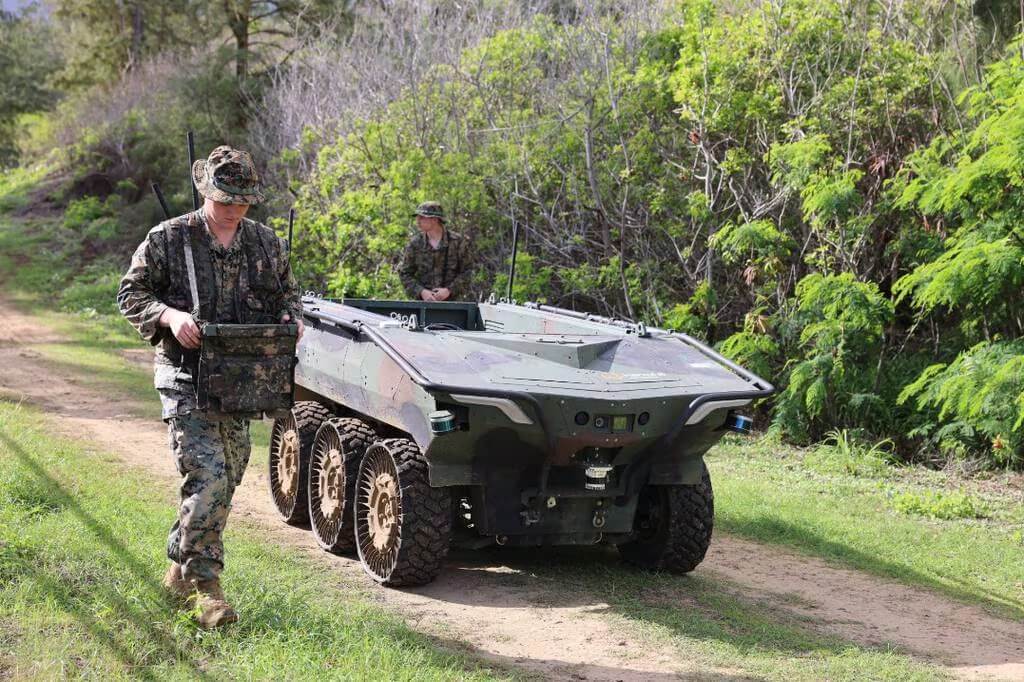INDUSTRY NEWS

Marines test robotic mule that could carry weapons, sensors
February 14, 2024
By:Todd South
Marines recently tested an unmanned ground vehicle that could transport gear provide mobile electrical charging and add firepower to small units.
Generally, these types of platforms carry gear for troops much like pack animals used to.
The Army’s current program for the vehicle is called the squad multipurpose equipment transport, or SMET. The Marines’ program is called multi-utility tactical transport, or MUTT.
The 3rd Littoral Logistics Battalion Marines at Marine Corps Training Area Bellows, Hawaii, conducted a foreign comparative test over two weeks in December 2023, alongside U.S. Army researchers, of the Hanwha Arion-SMET vehicle, according to a Marine press release.
David Keeler, Marine Corps Systems Command project lead, said, “UGVs can supplement tactical vehicle operations since they are highly transportable, can be moved to points of need quickly and don’t require licensed operators.”
Marines ran the vehicle on terrains such as a turf-covered sand beach course, soft sand, sand clay and bumpy, rutted roads, according to a press release from Hanwha, a South-Korean aerospace and green technology company. As part of the testing, Marines used the vehicle for heavy equipment transport, remote-controlled driving, waypoint navigation, physical tether following, soldier following and exploratory maneuvering.
The Arion-SMET is a six-wheeled electric vehicle that can carry 1,200 pounds, travel up to 62 miles and reach a top speed of 27 miles per hour on paved roads and 14 miles per hour on unpaved roads, according to the company.
General Dynamics builds the squad multipurpose equipment transport for the Army and was on track to deliver 675 platforms by October 2024 since winning the initial $249 million production contract in 2020, Breaking Defense reported.
The Marine Corps has not yet fielded an unmanned ground vehicle, said Morgan Blackstock, spokeswoman at Marine Corps Systems Command.
“Requirements are being reviewed for applications of (Unmanned Ground Vehicles), but have not been established at this time,” Blackstock wrote in an email response. “The data generated by the (Foreign Comparative Test) will assist the Marine Corps in defining requirements for (Unmanned Ground Vehicles).
The assistant secretary of the Army for acquisition, logistics and technology, told the outlet in October 2023 that increment II for the squad multipurpose equipment transport could include adding weapons or sensor packages.
The squad multipurpose equipment transport can cover 60 miles in a 72-hour period while carrying up to 1,000 pounds, according to Army specifications.
Hanwha’s recent comparative testing is part of a second wave of unmanned ground vehicle development for both services. While the original effort sought to carry unit equipment and provide mobile charging, the next steps could include weapons platforms.
The need for mobile transport and weapons platforms has been highlighted by recent conflicts.
Steve Duong, Systems Command’s international affairs specialist, said, “If you look at the war between Russia and Ukraine, you see each side is going after each other’s logistics support. That’s contested logistics.”
“What you don’t want is a big platform with a big signature transporting something like a tire or ammo back and forth because it can easily be identified by enemy sensors.”
Soldiers with the Airborne and Special Operations Test Directorate conducted simulated airdrop impact tests on the current squad multipurpose equipment transports in December 2023, according to an Army press release.
In 2016, Marines tested a tracked version of the multi-utility tactical transport that carried 600 pounds on land and 300 pounds while running amphibious for about 15 miles before power ran down, Marine Corps Times previously reported.
Source:
https://www.defensenews.com/news/your-marine-corps/2024/02/14/marines-test-robotic-mule-that-could-carry-weapons-sensors/

